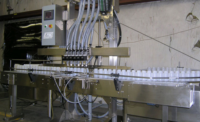Multiple industries utilize and rely on internationally accepted test standards to provide repeatable methods for comparison and quality assurance purposes. Rapid advancements in the film manufacturing industry have magnified the need to recognize that test methods may have small nuances, which can lead to varying results if they are not paid proper attention. By discussing some of the common problems that can occur with some common test procedures such as tensile, tear resistance, puncture resistance and coefficient of friction, these factors can be minimized and eliminated, thereby assuring the best test results possible for the film manufacturer.
Tensile testing is one of the main physical procedures performed on films. ASTM D882 Standard Test Method for Tensile Properties of Thin Plastic Sheeting is one of the most common industry standards for thin sheeting and films, where thin sheeting is defined as less than 1 mm in thickness. This test standard contains a standardized method for determining mechanical properties such as tensile strength, percent elongation, yield stress and Modulus of Elasticity used in engineering design.
ASTM D882 specifies test parameters based on the material behavior. By using the percent elongation at break, the standard specifies the appropriate initial strain rate and sample dimensions to use for testing. This is an exploratory step and will often require extra material to accomplish. By performing this step, the user ensures the proper strain rate is utilized and in compliance with the standard allowing for repeatable results.
It is important to provide sufficient material in order to accommodate the required sample length in addition to the extra needed for the exploratory set up. It is also important to properly label the machine and transverse directions for the sample material since many of the properties will be different in each orientation.
During sample preparation, ensure clean sample edges without any defects. Defects in the edges will cause premature failures at the site of the defect and lower force and elongation values. Determine the material properties of interest such as tensile strength, percent elongation, Modulus of Elasticity and yield strength ahead of time to prevent having to re-analyze the data after the test has been completed. It is also important to use appropriate grips and grip faces to minimize breakage at the grips or slippage.
Tear resistance testing is another common type of test used to characterize films. The most common tear tests are ASTM D1004, ASTM D1922 and ASTM D1938. One important consideration for tear testing is choosing the method that is most applicable to the material being tested. If the material is prone to tearing off-center, consider using a method like ASTM D1004 where the sample geometry encourages tearing in a specific area and direction.
Another factor in choosing the most relevant test method are the properties that need to be determined such as initiation force, propagation force, average tear force or total energy. ASTM D1922 will only yield the average tear force, ASTM D1004 will yield the tear initiation force, and ASTM D1938 can be used to determine all of the above properties. Be mindful to align the direction of tear with material orientation during sample preparation. The direction of tear is dependent on sample geometry thus labeling the orientation of the film is important.
Puncture resistance testing is also widely used to test films where common test methods include ASTM D1709, ASTM D3240 and ASTM F1306. Choosing the test method is often one of the more difficult steps for puncture testing. It is important to consider the end use of the film to determine the appropriate test method since the values for impact resistance from one method to another cannot be correlated to one another. Determining the material properties of interest can help guide the user to the proper test method.
For example, ASTM D1709 will only provide the mean failure energy to break for a group of samples where as ASTM F1306 will provide peak load, energy to break and penetration distance for every sample. For penetration tests like ASTM D1709 and ASTM D3420, it is important to provide enough material for testing and set up. These tests tend to take more exploratory work prior to testing to dial the test equipment into the proper range.
Another variable to determine is which side of the material to impact. Some films with laminate structures may have varying results for each impacted face of the material. During the test, it is also important to monitor and prevent slippage within the clamping mechanism, because this will give lower force and higher elongation results.
Coefficient of friction testing utilizing ASTM D1894 is another test that is important to film manufacturers; ASTM provides a constant means of quantifying this data. One of the more common issues with this test is making sure that the two surfaces to be in contact during testing are specified. These surfaces can be the same or they can be different depending on the end use. It is also important to consider which coefficient is relevant, static friction between non-moving surfaces versus kinetic friction between moving surfaces. This can help determine whether packaged materials will stay in place while on a pallet or to ensure a film feeds through a machine properly.
When preparing the test samples, it is important to have enough material such that no samples are reused. Reusing samples may lead to varying results, as samples wear down from moving across one another. Surface contamination from skin oils, adhesives or dust can also cause inconsistent results. Surfaces that have been contaminated may give different results versus clean material.
By combining the data determined by tensile, tear resistance, puncture resistance and coefficient of friction testing, the film manufacturer or end user can make informed decisions on the film selected. This data helps to ensure that a film is robust enough to withstand the potential stresses encountered in multiple failure modes and the film is capable of performing the intended task.
Utilizing standardized test methods also allows comparisons over time and treatments. By having a standard method, any lab should be able to replicate test results.
As in many other industries, there is constant innovation and development of new, more cost-effective and environmentally friendly materials. A good test lab will help its customers anticipate any implications associated with materials, including what has been discussed above. This leads to testing that is carried out in a reliable and repeatable manner, ultimately ensuring the most accurate results are obtained which leads to good decisions regarding the materials under test.
DDL
(800) 229-4235; www.testedandproven.com/






